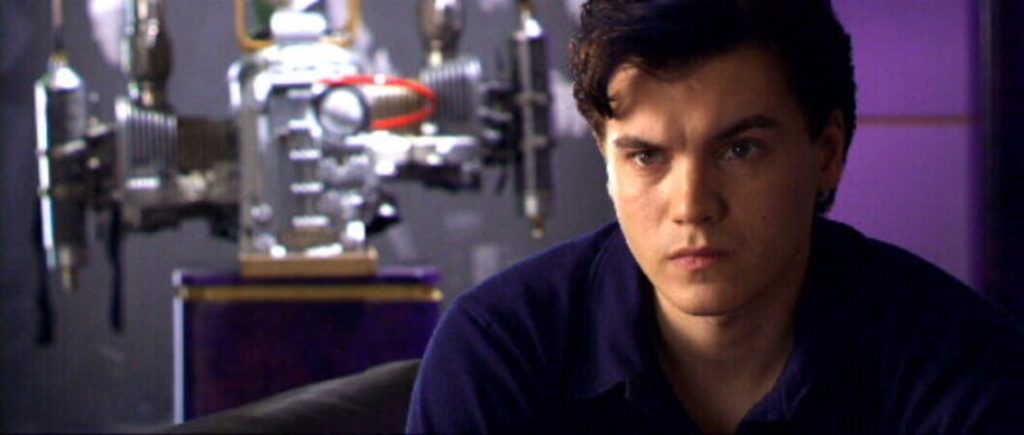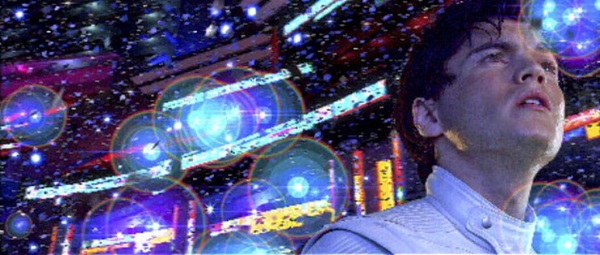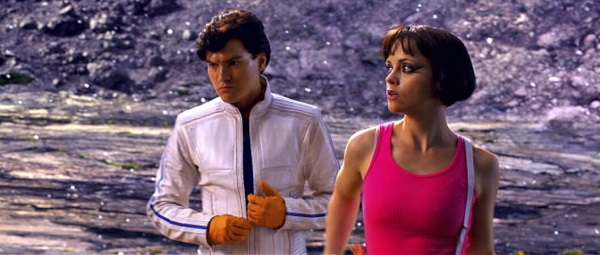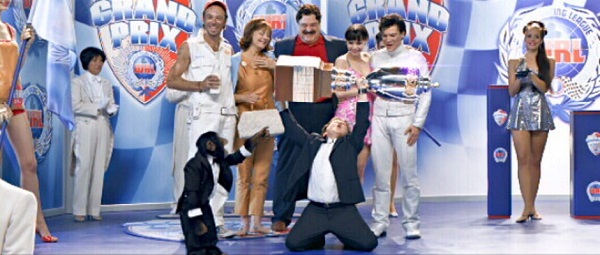
“Many critics felt alienated by it, dismissing it as pretty but vacant and of limited appeal. What they failed to recognize was that “Speed Racer” was a glimpse into the future of cinema, and showcasing a new way of telling stories to a generation of gamers.”
-NP Horton, On “Speed Racer” for “Den of Geek”
Spoilers for “Speed Racer”
For this essay to work, I have to start by defining one term. Normies: a colloquial expression used to define those with tastes that run alongside common consensus. It is a term that is often used derogatorily. Nobody, and I mean nobody, wants to be a normie; nor does anyone believe that they’re a normie. This raises a conundrum though—what actually is a normie then?
I had this epiphany while watching I’m Thinking of Ending Things, a film that I mostly hated and couldn’t put my finger on why. I just knew that I hated it, and the excited reactions of those trying to put the film together irked me so (I also knew that it would likely make a great Big Hot Mess candidate at some point in the near future, so expect to see a deep dive at some point soon). I felt very much like I had drifted into a territory where I had defined those who liked the film as having some implicitly defined flaw. That’s when the revelation struck: we define what normies are based off of whatever the antithetical content is to our own tastes.
I can’t possibly be a normie, because I like films and not The Big Bang Theory, even if my favorite film is Thor: Raganork. I can’t possibly be a normie unlike those who watch Marvel film, because I love A24 and NEON. I can’t possibly be a normie like those A24 stans, as I gravitate towards foreign art cinema. I can’t possibly be a normie, I watch the avant-garde and politically galvanizing documentaries which lack the bourgeoisie tendencies of foreign art. I can’t possibly be a normie, I don’t even like films, a statement that is probably the logical conclusion of such an idea.
If we’re being honest here, this phenomenon is not necessarily new. Speaking of I’m Thinking of Ending Things, Kaufmann includes the infamous Pauline Kael review for A Woman Under the Influence, which itself is written with a tone of “I can’t believe that people like this”. I don’t necessarily believe that explicit curation or taste calibration is a bad thing. Nor would I argue that art’s obscurity denigrates its greatness. There are masterpieces out there that I have never seen, and will likely never see, because I have no way of accessing them, and that does not preclude them from being masterpieces. If there’s one running thread I’ve tried to hold firm and fast to with this column, it’s that pretentiousness, in all of its forms, is perfectly acceptable.
Yet, something has shifted in recent years so that everyone is displaying a sense of pretentiousness at all times (which also offers another insight into why this is the most meaningless accusation anyone can throw at a film in 2020). As the culture shifts further and further towards ubiquitous pastiche and the perpetual recycling of IP, we start to lose track of what art even is. Thus, the only way to define art is to define it against a definition of normal. Being anti-normie is the new normie.
No film really defines this idea better than watching the Wachowskis’ Speed Racer in 2020 while hyperaware of the cult phenomenon that the film has become, a cult phenomenon that must simultaneously be reconciled with the film’s reception in 2008. It would be a mistake to suggest that Speed Racer didn’t have its vocal defenders back in May of 2008. It’s also a mistake to suggest that people actually loved this and that it was the pretentious voices of a few critics who loathed it. As much as one could make such a totalizing statement, “people” really didn’t enjoy this film; although, they definitely do now.
The 120-million-dollar question here, is why? Why not then, and why now? The often-cited thesis is that the film is was “ahead of its time,” although I really don’t see that being the case here. What Speed Racer offers a 2020 viewer is very different what it probably hoped to offer in 2008. The film offers its modern viewers a number of binary poles to choose from, each of which the support of the film (or lack thereof) aligns the viewer with a side; artistry vs. capitalism, celluloid vs. digital, gaming and anime vs. realism, fans vs. critics, and probably a whole litany more. If you wanted to make a “this art is actually misunderstood because,” bingo card, you’d probably fill it within the film’s glorious first act.
Let’s deconstruct one, specifically, the idea of celluloid and digital. Speed Racer is shot entirely in front of green-screens, which is what gives it the very plastic look that it has. There are two types of film that I think of when I think of Speed Racer. One is the hyper stylized, CGI focused films that existed in around the change of the decade that supposedly oozed limitless possibility like Scott Pilgrim vs. The World, parts of Southland Tales and the opening of Wong Kar-wai’s 2046. Yet, CGI swung hard the other way as Marvel roared into power, moving towards less expressive CGI that rendered very flat compositions and images. For as much as I like Captain American: The Winter Soldier’s attempts to be The Parallax View, I am very few delusions that the film is anything but kind of ugly looking.
Which probably is what has dragged some modern auteurs, especially the larger name ones like Nolan, Anderson and Tarantino towards tangible celluloid. Let’s be real here: nothing really screams normie taste like a profession of love for Quentin Tarantino in 2020. If you want to stick it to some annoying Letterboxd personality like Sean Baker—who is, undoubtedly, pretty annoying—you can make the point that this, in all of its digital glory, is the real cinema. Forget your celluloid fetishism, 35mm cannot offer the same expressive potential that Speed Racer does!
I recognize I am building a very big straw man here, and yet, it’s frustrating as hell to see praise for the visuals of a film that is also kind of ugly like those Marvel films. I’m deeply reminded of expressive CGI, but I am also deeply reminded of the litany of flat looking, multi-planed children’s films from the time. It’s difficult to watch Speed Racer knowing the film came out after monstrous Cat in the Hat, and not think, “you couldn’t have made this look any less ridiculous.” The Wachowskis’ work wonders in close-up. They have innumerable well-designed color palettes throughout the film. But when the film goes away from close-up, I can tell that I’m watching a more self-serious Spy Kids 3-D, the camp of which doesn’t distract from the very blunt earnestness with which The Wachowskis approach the material.
Which is where I actually think the deviation between the 2008 audience and the present audience comes from. Enough time has passed for people to forget that Speed Racer actually isn’t all that dissimilar from its 2008 contemporaries. Really, this isn’t that far removed from Coldplay and Justin Timberlake videos, and it really isn’t that far from Sharkboy and Lavagirl. There is probably some logic to the fact audience were not ready for Speed Racer in 2008. There’s also the possibility that audiences were too ready for it. There’s a weird contradiction at play that is hard to describe. Yes, few things, if any, look like Speed Racer. But also, Speed Racer feels like these very silly and ugly looking films of time-period and ilk. A question I asked myself on this re-watch, was if this was quite possibly the most 2008 film of all time?
In terms of cast, Speed Racer definitely is the most 2008 film ever made. For people with such a clearly big-hearted sense of imagination (and they are imaginative, don’t get me wrong), it’s amazing to think about how little The Wachowskis have of it at times. It drives me up the wall that Scott Porter is in this film. They literally cast Jason Street to play Jason Street! That is some real Ari Aster casting William Jackson Harper to play Chidi in this Swedish summer cult movie level silliness. Furthermore, I cannot think of a more 2008 touch than having Matthew Fox in a somewhat prominent role. These aren’t the people on the Wheaties box that you need to tell the tickets. These are the B-players. And yet, they scream 2008.
That’s because hiring network television’s rotating cast of golden boys to round out the bit-players in your 120-million-dollar toy commercial is a very 2008 choice. There is a very blunt and obvious anti-capitalism thread in Speed Racer, a film that really just a multi-act allegory for the Wachowskis entire career where they artist so hard that they invent a new color in the film’s final act. Yet, this allegory is attached to a film that was only made because Mattel smartly envisioned innumerable children’s toy tie-ins. For a film whose physics often seems akin to Hot Wheels based play than any form real-world race-car logic, the tie-in makes sense. Yet, it is a little disingenuous to be bludgeoned over the head with an earnest beyond belief anti-capitalism message inside of a film that is, for all intents and purposes, a 120-million-dollar toy commercial.
Which is to suggest that there’s nothing challenging or uncomfortable about watching Speed Racer in 2020. The film flopped. It did not recuperate its budget, and barring a multi-film HBO Max deal between Warner Bros and the Wachowskis, it is hardly likely that we’re going to ever get a sequel. It is a failed piece of capitalism, which means that you can fully embrace its anti-capitalist message. There are no more toys to be sold. If this is the most 2008 film of all time, then it is also the most comfortably nostalgic 2008 film of all time.
You can revel in this film’s potential, because it can’t ever possibly get closer. You can put the blinders on to say that the real issue is that film critics aren’t gamers, or that audiences are conditions to want banality, because who the hell is really going to challenge you on Speed Racer? I can assure you that I’m very close to the only person in this world who didn’t really appreciate the film the first time around, who has come back to the film. If you didn’t like this in 2008, you probably haven’t given it much thought since then.
You can also put the blinders on to an extent because the film is kind of an aberrant vision in a 2020 medial landscape. To buy into the nostalgia for just a second, for all I’ve said in complaining about the film’s occasionally ugly multi-planed use of long depth of field, its visuals that are far to akin to Bioshock for my liking, its 100% unironic lack of irony, and it’s uncomfortable dissonance regarding its anti-commercial commercialism, can anyone really say that Speed Racer is less interesting than the any of the Marvel films or the impending glut of Star Wars content that we’re getting for the next decade? Hell, Speed Racer probably has more to say than the Wachowskis own Matrix 4 will in a few months’ time.
In a sense though, this is the kind of anti-normie normie judgement that makes loving Speed Racer in 2020 intoxicating. The film is so nakedly earnest in its aims, while simultaneously having such a long and uninteresting second act, that you find yourself constantly evaluating and re-evaluating the film simply to have something to do. It would be foolish to suggest that the film’s barrage of constant stimulus would align Speed Racer to something slow and contemplative, but there’s a similar sensation to something like Jeanne Dielman, but for an entirely opposite reason.
Most of this stimulus is so meaningless that all I can really do is think about this film and its relationship to its place in history. The film is only really transcendent in its first and third acts, and yet, the perpetual montage of these two twenty-minute sequences are beyond arresting. What lies in between is a mushy middle filled with what I can only really describe as “anime inspired nonsense” that could probably be trimmed by a good twenty-five minutes.
In that space is where you graft your hopes and dreams onto Speed Racer. Audiences weren’t ready. The film is misunderstood. The Wachowskis are misunderstood. It’s definitely better than all of those Marvel films. All of the above misses why I think people actually didn’t like Speed Racer in 2008—it’s simply too obvious. Really, the film is “pretty but vacant,” its one-note ideas being coated in a candy-colored excess. In the real world, Speed signs with Royalton and the businesses keep playing art monopoly. In the world of the film, everything is neatly tied up in the happiest of possible endings. If you love this, you cannot help but wonder what sunk something this wondrously cotton-candy-like. The most comfortable explanation is the anti-normie normie one: people want conformity, and this colors outside the lines.
Ultimately, this is at the heart of all anti-normie normie arguments. We want to seem cool, and yet, cool in comfortable way. At the same time, no one really hates this. Those who dislike the film are indifferent to it, cheerily admitting that “it’s not their cup of tea”. That indifference is, I think, important here, because it’s indicative of the film’s fatal flaw.
Stripped of its requisite irony, Speed Racer posits a world where the kids win simply because they understand the rules of the art revolution and the stuffy boomers don’t. It’s a utopia that, deep down, we all want to be real. We want to feel like we control art, that we’re the ones in the know, that our medium is the one poised to truly change the game. To do that, you have to suggest that everything else isn’t really art. That’s for the normies. I’m different.









